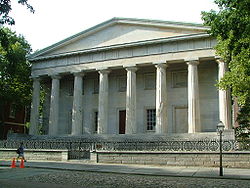Copyright © 2005-6, Henry J. Sage
 The history of the Bank of the United States is an interesting component of both the economic history of the United States, and the relationship among the government, the people and the American economy. The descendent of the first Bank of the United States, the present Federal Reserve System, is one of the most powerful monetary organizations in the world, and in some ways the issues surrounding the “Fed,” as it is called today, are the same as they were 200 years ago.
The history of the Bank of the United States is an interesting component of both the economic history of the United States, and the relationship among the government, the people and the American economy. The descendent of the first Bank of the United States, the present Federal Reserve System, is one of the most powerful monetary organizations in the world, and in some ways the issues surrounding the “Fed,” as it is called today, are the same as they were 200 years ago.
More than any other individual, Alexander Hamilton was responsible for the creation of the first Bank of the United States. Starting with his early experience in the West Indies, Hamilton understood finance as well as any of his contemporaries, and better than most. Serving on Washington's staff during the American Revolution, he saw firsthand the problems that arose from a weak government financial structure. After the war he was involved in creating a bank in New York City and continued to be cognizant of the financial affairs of the country. Hamilton's participation in the process that eventually led to the writing of the Constitution came in part from his concern over the economic future of the country.
As first United States Secretary of the Treasury, Hamilton came up with a financial plan to put the country on a sound financial footing. A cornerstone of the structure he envisioned was a national bank. Although the Constitution did not specifically authorize Congress to create a bank, Hamilton argued in his proposal to President Washington that the powers granted Congress under the Constitution certainly implied lesser powers to make the carrying out of its duties more efficient. Thomas Jefferson disagreed, but Washington sided with Hamilton, and the first Bank of the United States was chartered for 20 years. By the time its charter expired in 1811, Hamilton was dead and Jefferson's protégé, James Madison, was president, and Republicans ruled Congress. The bank was not re-chartered.
Following the war of 1812, however, Madison appreciated the wisdom of having a national bank, and in 1816 the second Bank of the United States was chartered for another 20 years. The bank was always surrounded by controversy for various reasons. One was that foreign investors provided some of the capital for the bank, and the bank's critics felt that its purpose was to enrich the pockets of the wealthy at the expense of the less fortunate. Under the Bank's charter, state banks were also brought under some control, as any State Bank currency that came into possession of the national Bank had to be redeemed by the State Bank in gold. That prevented state banks from issuing more paper currency and they could safely back, a process which tended to discourage speculation and control inflation. But speculators and borrowers, people who were purchasing vast tracts of land owned by the federal government, wanted loose money, and they were not all at all hurt by inflation. Rather, when the time came for them to repay their loans, an inflated currency made it easier for them to settle their debts. At the same time, of course, debts repaid in inflated currency tended to reduce the profits made by banks on their loans.
What all this meant was that the bank had strong supporters and opponents, depending upon where they were located within the national financial structure. In 1832 the bank was controlled by financier Nicholas Biddle, and he and other supporters of the bank, including Whigs in Congress, decided that although the bank's charter was not scheduled to run out until 1936, they could use the bank as an issue in the electoral campaign of 1832. Knowing that Andrew Jackson was vigorously opposed to the bank, and believing that the American people were were generally in favor of the bank, they thought they could solve two problems by the same act. They passed a bank charter bill thinking that if Andrew Jackson vetoed it, it would cost him the presidency. If the charter went through, the life of the bank would continue and Jackson could do nothing about it.
Jackson, however, vetoed the bank bill. [See Jackson's Veto Message.] He also won the election of 1832, claiming that the bank had tried to kill him but he had killed it. Jackson claimed that the bank was unconstitutional, and when reminded that John Marshall in the case of McCulloch v. Maryland had argued that the bank was constitutional, using the same reasoning that Alexander Hamilton used to create the bank in the first place, Jackson retorted that “Marshall has his view of the Constitution and I have mine.” He was not impressed with Marshall's opinions.
In any case the bank was killed in 1832, and when its charter ran out in 1836 it had been virtually dismantled. That was the last national banking system that existed until the Federal Reserve was created in 1913.
| Jeffersonian Home | Jacksonian Home | Economic Growth to 1860 |
| Sage American Home | Antebellum America | Updated December 14, 2016 |